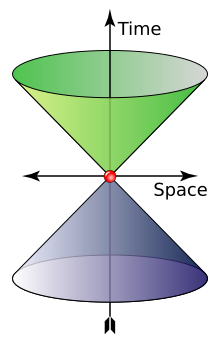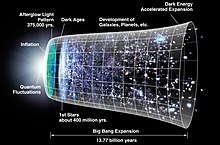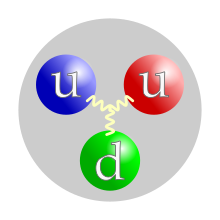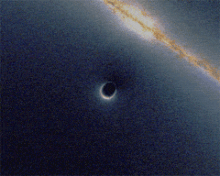A Brief History of Time
| Author | Stephen Hawking |
|---|---|
| Genre | Cosmology |
| Publisher | Bantam Books |
Publication date | 1988 |
Published in English | 1988 |
| Followed by | The Illustrated A Brief History of Time |
A Brief History of Time (1988) is a book written by the scientist and mathematician Stephen Hawking. The subject of the book is cosmology, the story of the universe.
There are two other versions of this book: The Illustrated A Brief History of Time and A Briefer History of Time. The Illustrated A Brief History of Time has pictures to help explain its ideas. It was also updated because new information was found. A Briefer History of Time is shorter than the first version and was also updated.
This book is very popular and well-known. This book was on the London Sunday Times bestseller list for over 4 years.[1]
Summary[change | change source]

In this book, Hawking talks about many theories in physics. Some of the things that he talks about are the history of physics, gravity, how light moves in the universe, space-time, elementary particles (very small objects that make up things in the universe), black holes, the Big Bang (the theory that the universe started from one point), and time travel (the idea that travel can be done to the past and to the future.)
In the first part of the book, Hawking talks about the history of physics. He talks about the ideas of philosophers such as Aristotle and Ptolemy. Aristotle, unlike many other people of his time, thought that the Earth was round. He also thought that the sun and stars went around the Earth. Ptolemy also thought about how the sun and stars were located in the universe. He made a planetary model that described Aristotle's thinking. Today, it is known that the opposite is true; the earth goes around the sun. The Aristotle/Ptolemy ideas about the position of the stars and sun was disproved in 1609. The person who first thought of the idea about the Earth going around the sun was Nicholas Copernicus. Galileo Galilei and Johannes Kepler, two other scientists, helped to prove that Copernicus's idea was right. They looked at how the moons of some planets moved in the sky, and they used this to prove Copernicus right. Isaac Newton also wrote a book about gravity, which helped to prove Copernicus's idea right.
Space and Time[change | change source]

Hawking describes the motion of planets moving around the sun and how gravity works between the planets and the sun. He also talks about the ideas of absolute rest and absolute position. These ideas are about the thought that events stay in place over a period of time. This was found not to be true by Newton's laws of gravity. The idea of absolute rest did not work when objects move very fast (at the speed of light, or light speed).
The speed of light was first measured in 1676 by the Danish astronomer Ole Christensen Roemer. The speed of light was found to be very fast, but at a finite speed. However, scientists found a problem when they tried to say that light always travelled at the same speed. The scientists created a new idea, called the ether, which tried to explain light's speed.

Albert Einstein said the idea of the ether was not needed if another idea, the idea of absolute time (or time that is always the same) was dropped. Einstein's idea was also the same as Henry Poincare's idea. Einstein's idea is called the theory of relativity.
Hawking also talks about light. He says that events can be described by light cones. The top of the light cone tells where the light from the event will travel. The bottom tells where the light was in the past. The center of the light cone is the event. Besides light cones, Hawking also talks about how light can bend. When light goes past a big mass, like a star, the light changes direction slightly towards the mass.
After talking about light, Hawking talks about time in Einstein's theory of relativity. One prediction that Einstein's theory makes is that time will go by slower when something is near huge masses. However, when something is farther away from the mass, time will go by faster. Hawking used the idea of two twins living at different places to describe his idea. If one of the twins went to live on a mountain, and another twin went to live near the sea, the twin who went to live on the mountain would be a little bit older than the twin who went to live at the sea.
The Expanding Universe[change | change source]

Hawking talks about the expanding universe. The universe is getting bigger over time. One of the things he uses to explain his idea is the Doppler shift. The Doppler shift happens when something moves toward or away from another object. There are two types of things that happen in Doppler shift - red shifting and blue shifting. Red shifting happens when something is moving away from us. This is caused by the wavelength of the visible light reaching us increasing, and the frequency decreasing, which shifts the visible light towards the red/infra-red end of the electromagnetic spectrum. Red-shift is linked to the belief that the universe is expanding as the wavelength of the light is increasing, almost as if stretched as planets and galaxies move away from us, which shares similarities to that of the Doppler effect, involving sound waves. Blue shifting happens when something is moving toward us, the opposite process of red-shift, in which the wavelength decreases and frequency increases, shifting the light towards the blue end of the spectrum. A scientist named Edwin Hubble found that many stars are red shifted and are moving away from us. Hawking uses the Doppler shift to explain that the universe is getting bigger. The beginning of the universe is thought to have happened through something called the Big Bang. The Big Bang was a very big explosion that created the universe.
The Uncertainty Principle[change | change source]
The uncertainty principle says that the speed and the position of a particle cannot be found at the same time. To find where a particle is, scientists shine light at the particle. If a high frequency light is used, the light can find the position more accurately but the particle's speed will be unknown (because the light will change the speed of the particle). If a lower frequency light is used, the light can find the speed more accurately but the particle's position will be unknown. The uncertainty principle disproved the idea of a theory that was deterministic, or something that would predict everything in the future.

How light behaves is also talked more about in this chapter. Some theories say that light acts like particles even though it really is made of waves; one theory that says this is Planck's quantum hypothesis. A different theory also says that light waves also act like particles; a theory that says this is Heisenberg's uncertainty principle.

Light waves have crests and troughs. The highest point of a wave is the crest, and the lowest part of the wave is a trough. Sometimes more than one of these waves can interfere with each other - the crests and the troughs line up. This is called light interference. When light waves interfere with each other, this can make many colors. An example of this is the colors in soap bubbles.
Elementary Particles and Forces of Nature[change | change source]
Quarks are very small things that make up everything we see (matter). There are six different "flavors" of quarks: the up quark, down quark, strange quark, charmed quark, bottom quark, and top quark. Quarks also have three "colors": red, green, and blue. There are also anti-quarks, which are the opposite of the regular quarks. In total, there are 18 different types of regular quarks, and 18 different types of anti quarks. Quarks are known as the "building blocks of matter" because they are the smallest thing that make up all the matter in the universe.

All elementary particles (for example, the quarks) have something called spin. The spin of a particle shows us what a particle looks like from different directions. For example, a particle of spin 0 looks the same from every direction. A particle of spin 1 looks different in every direction, unless the particle is spun completely around (360 degrees). Hawking's example of a particle of spin 1 is an arrow. A particle of spin two needs to be turned around halfway (or 180 degrees) to look the same. The example given in the book is of a double-headed arrow. There are two groups of particles in the universe: particles with a spin of 1/2, and particles with a spin of 0, 1, or 2. All of these particles follow Pauli's exclusion principle. Pauli's exclusion principle says that particles cannot be in the same place or have the same speed. If Pauli's exclusion principle did not exist, then everything in the universe would look the same, like a roughly uniform and dense "soup".

Particles with a spin of 0, 1, or 2 move force from one particle to another. Some examples of these particles are virtual gravitons and virtual photons. Virtual gravitons have a spin of 2 and they represent the force of gravity. This means that when gravity affects two things, gravitons move to and from the two things. Virtual photons have a spin of 1 and represent electromagnetic forces (or the force that holds atoms together).
Besides the force of gravity and the electromagnetic forces, there are weak and strong nuclear forces. Weak nuclear forces are the forces that cause radioactivity, or when matter emits energy. Weak nuclear force works on particles with a spin of 1/2. Strong nuclear forces are the forces that keep the quarks in a neutron and a proton together, and keeps the protons and neutrons together in an atom. The particle that carries the strong nuclear force is thought to be a gluon. The gluon is a particle with a spin of 1. The gluon holds together quarks to form protons and neutrons. However, the gluon only holds together quarks that are three different colors. This makes the end product have no color. This is called confinement.
Some scientists have tried to make a theory that combines the electromagnetic force, the weak nuclear force, and the strong nuclear force. This theory is called a grand unified theory (or a GUT). This theory tries to explain these forces in one big unified way or theory.
Black Holes[change | change source]

Black holes are stars that have collapsed into one very small point. This small point is called a singularity.This singularity is a point of space-time which rotates at a high speed.That is the reason that black holes have no time. Black holes suck things into their center because its gravity is very strong. Some of the things it can suck in are light and stars. Only very large stars, called super-giants, are big enough to become a black hole. The star must be one and a half times the mass of the sun or larger to turn into a black hole. This number is called the Chandrasekhar limit. If the mass of a star is less than the Chandrasekhar limit, it will not turn into a black hole; instead, it will turn into a different, smaller type of star. The boundary of the black hole is called the event horizon. If something is in the event horizon, it will never get out of the black hole.
Black holes can be shaped differently. Some black holes are perfectly spherical - like a ball. Other black holes bulge in the middle. Black holes will be spherical if they do not rotate. Black holes will bulge in the middle if they rotate.
Black holes are difficult to find because they do not let out any light. They can be found when black holes suck in other stars. When black holes suck in other stars, the black hole lets out X-rays, which can be seen by telescopes. Hawking talks about his bet with another scientist, Kip Thorne. Hawking bet that black holes did not exist, because he did not want his work on black holes to be wasted. He lost the bet.
Hawking realized that the event horizon of a black hole could only get bigger, not smaller. The area of the event horizon of a black hole gets bigger whenever something falls into the black hole. He also realized that when two black holes combine, the size of the new event horizon is greater than or equal to the sum of the event horizons of the two other black holes. This means that a black hole's event horizon can never get smaller.
Disorder, also known as entropy, is related to black holes. There is a scientific law that has to do with entropy. This law is called the second law of thermodynamics, and it says that entropy (or disorder) will always increase in an isolated system (for example, the universe). The relation between the amount of entropy in a black hole and the size of the black hole's event horizon was first thought of by a research student (Jacob Bekenstein) and proven by Hawking, whose calculations said that black holes emit radiation. This was strange, because it was already said that nothing can escape from a black hole's event horizon.
This problem was solved when the idea of pairs of "virtual particles" was thought of. One of the pair of particles would fall into the black hole, and the other would escape. This would look like the black hole was emitting particles. This idea seemed strange at first, but many people accepted it after a while.
The Origin and Fate of the Universe[change | change source]
Most scientists believe that the universe started in an explosion called the Big Bang. The model for this is called the "hot big bang model". When the universe starts getting bigger, the things inside of it also begin to get cooler. When the universe was first beginning, it was infinitely hot. The temperature of the universe cooled and the things inside the universe began to clump together.
Hawking also talks about how the universe could have been. For example, if the universe formed and then collapsed quickly, there would not be enough time for life to form. Another example would be a universe that expanded too quickly. If a universe expanded too quickly, it would become almost empty. The idea of many universes is called the many-worlds interpretation.
Inflationary models are also discussed in this chapter, and so is the idea of a theory that unifies quantum mechanics and gravity.
Each particle has many histories. This idea is known as Feynman's theory of sum over histories. A theory that unifies quantum mechanics and gravity should have Feynman's theory in it. To find the chance that a particle will pass through a point, the waves of each particle needs to be added up. These waves happen in imaginary time. Imaginary numbers, when multiplied by themselves, make a negative number. For example, 2i X 2i = -4.
Other editions[change | change source]
- 1988 — The first edition is published. This edition had an introduction by Carl Sagan.
- 1990 - Similar to the 1996 but with an introduction by Carl Sagan, uncolored pictures, and it was printed in paperback
- 1996 — An illustrated, updated and expanded edition is published, called The Illustrated A Brief History of Time. This hardcover edition contains full color illustrations and photographs to help explain the text. It also has topics not in the original book, including a new chapter on wormholes and time travel.
- 1998 — The Tenth Anniversary Edition is published. It has the same text as the one published in 1996, but was also released in paperback and has less diagrams.
- 2005 — The release of A Briefer History of Time (written with Leonard Mlodinow), which is a shorter version of the original book. It was updated again to include new scientific developments..
Notes[change | change source]
- ↑ "Stephen Hawking's Universe". PBS Online. Archived from the original (HTML) on 2008-06-09. Retrieved 2008-06-11.
References[change | change source]
- Hawking, Stephen (1996) [1988]. The Illustrated A Brief History of Time. New York: Bantam Books. pp. 248. ISBN 9780553103748. ISBN 0-553-10374-1
